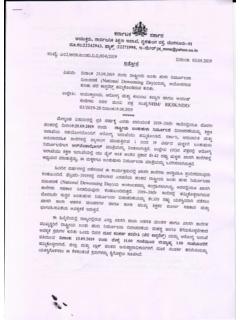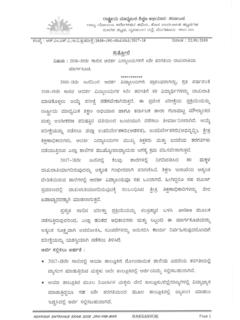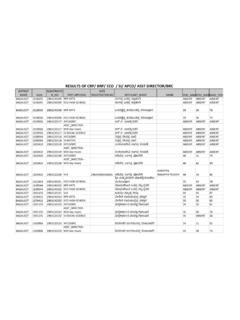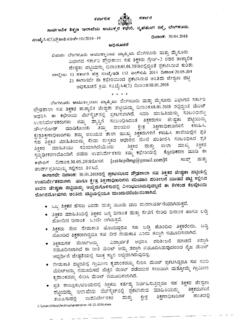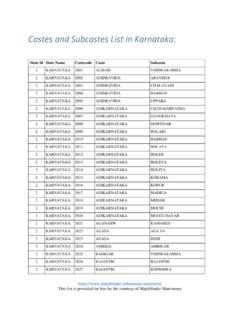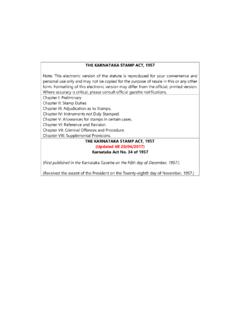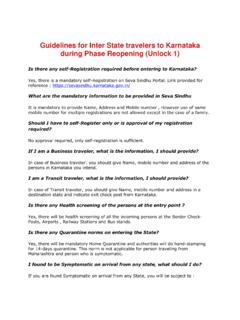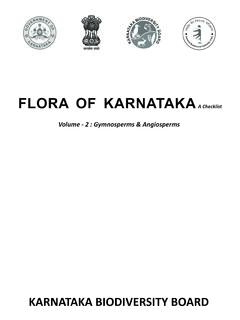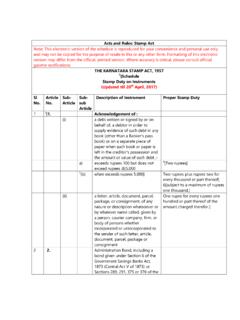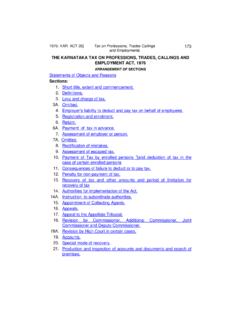Transcription of School Education in Karnataka
1 School Education in Karnataka 1 Department of Primary and Secondary EducationSchool Education in Karnataka2018-192 Government of KarnatakaFor detailed Educational Indicators for Karnataka , please visit: For a better understanding of Educational Indicators, please visit: School Education in Karnataka 3 OverviewWith over 77,000 schools, crore students and 3 lac teachers, The Departmentof Primary and Secondary Education has undertaken various initiatives toimprove the quality of Education in the state. These efforts are made possible due tothe collaborative efforts of the teachers, functionaries, civil society organizations andother stakeholders. All the initiatives are undertaken with an aim to improve access,equity and to ensure all students are learning well. Due to the sustained efforts inthe last 3-4 years, we are seeing a gradual improvement in a few indicators acrossthe districts.
2 Greater understanding of the learning levels through the C-SAS andSSLC results across the districts. This year initiatives such as the launch of EnglishMedium and Pre-Primary Sections in the schools, revitalizing Special educationand Karnataka Public Schools have been undertaken to further improve access andstrengthen the government schooling system. The document is aimed to help thereader get an overall view of public Education in the state of Karnataka . This reporthas three parts (i) Educational profile of the state on some key indicators from 2018-19,(ii) Key initiatives that have been undertaken by the department, and(iii) Case studies showcasing good practices from the Government of KarnatakaEducation Profile of the StateSection 1 Performance Grade Indicators (PGIs)The Performance Grade Indicators are a 70-point Grading Index for assessing schooling systems across states .
3 The Index assesses the states on a 1,000 point grading system. The PGIs are aimed at helping states understand where they may be lagging behind and prioritise areas for intervention to ensure that the School Education system is robust at every WeightNational outcomes and quality180137160 Access outcomes806569 Infrastructure and facilities15096100 Equity outcomes230205212 Governance processes360190165 Total1000693706 School Education in Karnataka 5 Key Educational Indicators Schools and enrollment across all institutions - Public & Private Enrollment from pre-primary to secondary Education schools in Karnataka are funded by the Department of enrollments in Karnataka are in schools funded by the Department of %55 %No. of Enrollments (in Lakhs)5060403010020 Grade 1-5 (6-10y)Primary55,03,96050,943 teachersGrade 9-10 (14-15y)Secondary86804teachers18,00,674 Pre - PrimaryLKG & UKG (3-5y)5,97,346 Anganwadis run by the WCD also caters to the same age group Grade 6-8 (11-13y)Upper Primary165741teachers30,72,836 GovtOthersPrivateAided**Others - include Tribal / Social Welfare Department Schools and Central Govt.
4 Schoools0 %20 %40 %60 %80 %1%100 %1,50119,7697,25648,2101,03,77,380 enrollments in Karnataka2,60,26113,36,55643,79,25444,01 ,30976,744 schools in KarnatakaSchoolsEnrollments6 Government of KarnatakaPrimary(Grade 1 - 5)Upper Primary(Grade 6 - 8)Secondary(Grade 9 -10)BoysGirlsTotalBoysGirlsTotalBoysGirl sTotal1. Net Enrolment Retention Transition Avg Annual Promotion The Net Enrolment Ratio indicates the enrolment of the official age-group for a given level of Education expressed as a percentage of the corresponding population. This is a very important indicator in measuring rates of Access to Education . For In Karnataka , with NER in Secondary Education at It shows that out of every 100 students within the official age group of secondary Education , only 66 were enrolled in School . The Retention Rate indicates the percentage of students who remain at a School after they begin studying there.
5 A high retention rate suggests that the School provides a supportive environment to the student to continue his studies. In Karnataka , the retention rates are high at the Primary and Upper Primary level. The Transition Rate indicate the percentage of students who have transitioned from one level of Education to the next. A high transition level indicates a high level of access and vice versa. The transition rates at Primary School level are above 100 due to new enrollments. School Education in Karnataka 7 Pupil-Teacher Ratio (PTR) Ratio specified in Right to Education norms PTR across all institutions Overall PTR for working teachers across each stage of Education PrimaryUpper Primary1:301:35 OthersPrivateAidedPrimaryUpper Government of KarnatakaStudent-Classroom Student Classroom Ratio shows the average number of students per classroom in primary/upper primary/secondary schools in a given School -year.
6 This is often used as a proxy for adequate infrastructure (number of classrooms in the School ).Student-Classroom Ratio across all institutions OthersPrivateAidedGovtElementary School Education in Karnataka Gender-wise EnrollmentsThe Gender Parity Index (GPI) indicates parity between girls and boys. A GPI of less than 1 suggests girls are more disadvantaged than boys in learning opportunities and a GPI of greater than 1 suggests the other way Parity Index:PrimaryGrades 1-5 Grades 6-8 Grades 1-8 Upper across institutions, by Education level No. of enrollments (in lahks)GovtOthersPrivateAidedGender distribution across all schools (Grade 1-10) 0%20%40%60%80%100% Grand Government of KarnatakaB. Grade-wise EnrollmentsTotal number of enrollments across grades (in lakhs) Grade-wise categorization of institutions GovtOthersPrivateAidedGrade 10 Grade 9 Grade 8 Grade 7 Grade 6 Grade 5 Grade 4 Grade 3 Grade 2 Grade 1 LKG & UKG0246810125,97,36111,27,782 10,77,610 11,02,743 11,05,053 10,90,682 10,56,407 10,34,878 9,81,551 9,47,844 8,52,830 School Education in Karnataka 11C.
7 Social Category-wise EnrollmentsThis graph clearly shows that the most underprivileged social groups access the Government Schools GovtOthersPrivateAided1,13,03227,44,4898 ,63,20726,42,78377,8044,94,5802,87,66911 ,06,51333,5411,64,61294,6434,95,29526,74 67,78,96922,85,805,82,0840 %20 %40 %60 %80 %100 %MuslimsSTSCOBCG eneral35,8849,97,62891,0371,34,66312 Government of Karnataka0%20%40%60%80%100%Others PrivateAidedGovt0%20%40%60%80%100%0%20%4 0%60%80%100%4852604023785149465470313565 53474753564432685347 Teacher PrimarySecondary50,943 teachers165,751 teachers86,804 teachersGender distribution of teachers across institutions and Education levels:MenWomenNo. of Teachers (in thousands)PrimaryPrimaryUpper PrimaryUpper PrimarySecondarySecondaryNumber of teachers across institutions and Education levels:030609012039,51444210,627360120,9 865,44537,048227236,02313,79233,9843005 OthersPrivateGovtAided School Education in Karnataka 13< 5555-70> 70 Learning National Achievement Survey (NAS)B.
8 Census-based State Achievement Survey (C-SAS)GradeLanguagesCore SubjectsOverallL1L2L3 MathsEVS / ScienceSocial Studies47266- 7071-7056770-7277- 7167169646366686777371616463666686654586 15358589715165594866601066495253586758 Overall70626064636563 The findings from the C-SAS are mostly in line with the NAS. The findings help in the design of the Remedial program that is run by the state and also plan other interventions to improve learning. Languages Kannada/English/Urdu/Hindi/Marathi/Tamil depending on the regionRedOrangeGreen020406080100 Class 8 Class 5 MathClass 3 EVSLangMathEVSLangMathEVSLang65686457585 357424474 78 75 68 71 67 6351 51 Achievement by Classes and Subjects NationalKarnataka14 Government of KarnatakaKey Initiatives of the DepartmentSection 2 KPS is an initiative introduced by the Department of Education , GoK to address the quality of Education and the falling enrolment in government schools.
9 These schools will provide an integrated Education from the pre-primary level to the pre-university level to students under the same institution. The Department will ensure that the KPS schools will have adequate infrastructure, Labs, teaching and non-teaching staff and other resources that will enable the imparting of quality Education . Separate organizational rules and guidelines for these schools are being prepared. Presently 176 schools have been selected as KPS with further addition of another 100 schools in 2019-20, taking the total number to 276 KPS Schools. An online portal has also been developed for the KPS schools. Karnataka Public Schools (KPS)1. School Education in Karnataka 15 With a view to improving access to Early Childhood Education , The Department of Education has planned to start pre-primary grades in selected schools in the coming year.
10 In this regard, the SSK is working closely with the Women and Child Welfare Department (WCD), UNICEF and other partner NGOs for the preparation of the curriculum for pre-primary, norms for Teacher recruitment, Curriculum design, Teacher Handbook, Infrastructure norms and Nutritional aspects for 2019-20 rollout. Pre-primaryEnglish MediumSpecial Department has planned to start English medium classes along with the existing Kannada medium in 1000 government Schools. English-medium classes will be introduced in class 1 in 2019-20. The expansion will happen incrementally and in a phased manner. The bilingual textbooks, MRP training, module development for MRP training, teacher handbook and resource book, tools and processes for teacher needs analysis have been completed. The teacher training by districts are underway with support from the Regional Institute of English, Bengaluru.
